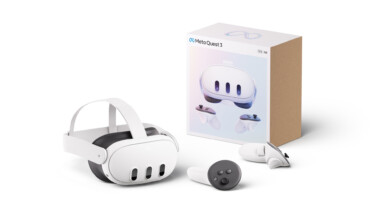Meta is stingy with the storage capacity of the Quest 3 entry-level model. Meta’s CTO explains the decision.
Meta Quest 3 comes in two SKUs: one with 128GB of storage for $499 and one with 512GB of storage for $650. The entry-level version has 128 instead of 256GB of storage, which is a bit surprising given the higher price point and other factors.
Storage on the entry-level model is tight: After subtracting the space taken up by the system software, that leaves about 100GB for games, apps, and media. Most VR games take up 1–3 gigabytes, but there are popular VR games like Resident Evil 4 and Red Matter 2 (both 8GB), Iron Man VR (10GB), and The Walking Dead: Saints & Sinners 2 (12GB) that take up many times that. And upcoming blockbusters like Asgard’s Wrath 2 are likely to add significantly to that.
The Quest 3’s lifecycle has just begun, and VR games optimized for the new headset require more storage. What seems sufficient today may not be enough in a year or two, forcing users to regularly uninstall games to free up space on their device.
Quest 2 ran into the same issues
The Meta Quest 2 had a similar story: the entry-level model of the device launched with 64GB of storage, which proved to be a bit on the short side, prompting Meta to upgrade the storage to 128GB a year after launch. Those who bought the smaller storage model were left with a bad taste in their mouths.
It is unfortunate that Quest 3 does not come with 256GB of storage. But obviously Meta wanted to save costs here. The question is whether it was in the right place.
In his latest Q&A session on Instagram, Meta’s CTO Andrew Bosworth had the following to say about this choice:
Which storage option is right for you?
Bosworth is referring to the fact that the 512GB version sold out in many places shortly after launch. This happened because fans and enthusiasts snapped it up immediately, proving Meta’s strategy right.
But Bosworth’s reasoning raises questions: Does he think that VR enthusiasts who want to use the device as a standalone gaming device should immediately go for the 512GB version? That would probably be at least 90 percent of users. In this case, the device is primarily aimed at enthusiasts who are willing to pay way more than normal consumers. This would also explain why the official Quest 3 accessories are so blatantly overpriced.
But what about those who don’t want to spend that kind of money? They have to put up with the inconvenience of regular storage management and hope that upcoming blockbusters like Asgard’s Wrath 2 don’t take up 50 gigabytes or more.
For those who consume a lot of media besides games and want to store immersive videos on their Quest 3, I would recommend biting the bullet and getting the 512GB version. Or wait a year and see if Meta upgrades the Quest 3’s entry-level model to 256GB.
Source: Mixed News







